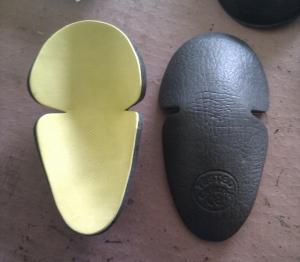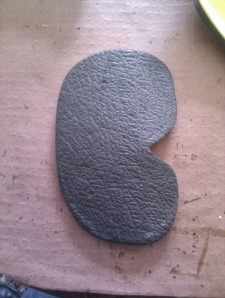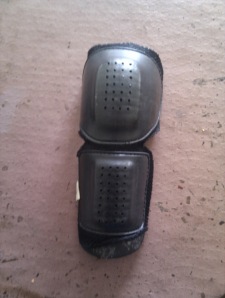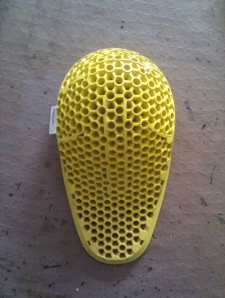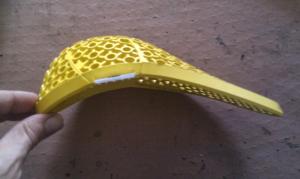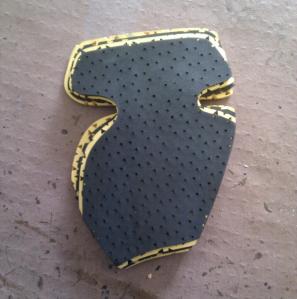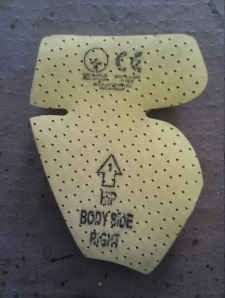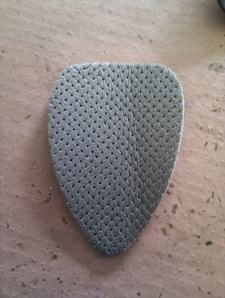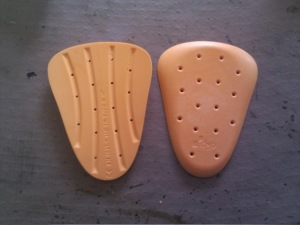So I have some pretty decent kit, some mid-price kit and some cheap kit. I’ve crashed in some of it. Worst I’ve had is some ligament damage from throwing my bike down the road in a different direction to myself and not getting my foot out from under it before rolling over. Didn’t hit the solid object, all is good.
That’s the knee armour I was wearing when I did that. Dual layer foam. It’s been in storage for about two years and is going crusty and brittle around the edges. See the waffle pattern on the inside of the left pad? That’s the weave of the trousers embossed into the foam. I think these were done with. Granted that knee hit the ground and at least one layer of the 1200 denier nylon was worn through so it did its job, don’t think it would work as well a second time.
Here’s the hip armour that came with it. No CE approval marking. Trousers were advertised as having CE approved armour in the knee and hip. Buyer beware. Note that some of the edge looks slightly blistered? This matches the scuff mark in the outside of the trousers that follows the outline of the hip insert. I’m quite glad it was there. Again, single use. Would I buy those trousers again? Yes if that was my budget. They were cheap and did their job.
Above is an elbow pad from my leather jacket, approved to EN1621-1 1997 as a type A elbow protector. The type A means it’s the smaller coverage area, and given the thin foam across most of it, I suspect only the vented area would dissipate the 50 joule test load with no more than 35kN as required. I’d expect to see this kind of armour used for skateboards and similar with the addition of a little velcro. The plastic shell is great for abrasion resistance but that’s what the surrounding leather jacket is for. Accordingly this is not in a jacket.
Some maths:
Work = Force x Distance
Work/Force = Distance
Therefore we can calculate the distance over which minimum standard armour will dissipate the test force. In this case EN1621-1:1997 armour will dissipate the 50J force over at least 1.4mm. 50J is the same amount of energy as a mass of approximately 5kg dropped from a metre. That’s not huge compared to the forces involved in an accident. Consider how thick the armour is and how much more it can deform before it becomes useless. In the case of the above armour much more.
EN1621-1:2012 brings in tiered standards, level one as we know it, and level 2 specifying a maximum of 20kN in the same test, which means a dissipation over at least 2.5mm. This standard also requires that performance be retained after hydrolythic ageing and in cold, hot and wet conditions.
The above armour is Forcefield Net armour, one of the few aftermarket products that meets EN-1621-1/2012 Level 2, and on the B template so sized for a large person. I bought some for my RST leather trousers. It’s remarkably flexible, quite light and easily conforms to the shape of my knees, I shall have more of these. Hopefully I won’t test the claim that these work for repeated impacts, as I have plenty of armour with permanent marks in it. The original armour was the RST A-template armour shown below.
I can’t see why RST put this in their products, the pocket is big enough for a B-template insert but they’ve cut away at it to make it smaller and lighter the internal curvature is too small so the edges dig into my knee.
The RST trousers had no hip armour, but there were pockets for some. The forcefield hip armour is made from 4 layers of Nitrex and can be easily cut to shape. It’s only level 1, but it’s arguably the best that I could find.
My IXS Tromso trousers came with some kind of comfort padding as pictured above. It’s no better than cardboard. Initially used the forcefield insert, as these are the same shape as my RST trousers. The shape matches well with a D3O insert, so I’m trying those in the IXS trousers. The D3O material is a non-newtonian oobleck-like material, the harder you hit it the stiffer it gets. It’s more flexible than the Forcefield and has smoother edges, so it’s less likely to present a hard edge behind the less abrasion resistant textiles.
I’ve not got my hands on any knox aftermarket kit yet. I’ll find some inserts that knox upgrades and write them up separately.
See also:

